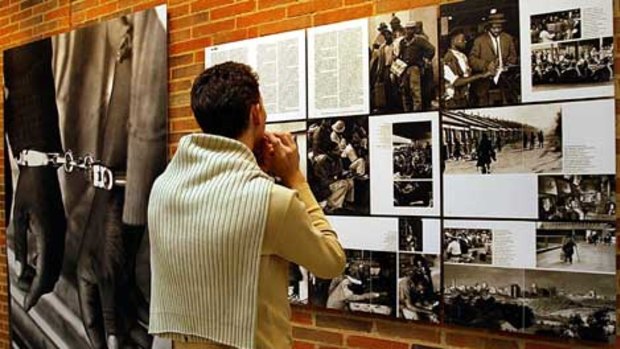
Inside South Africa's apartheid museum - a gut-punching monument to the country's brutal past.
Photo: AFP
Apartheid museum is a chilling link to South Africa's brutal past, writes Phil Lutton.
I take a jet-lag fuelled gulp of morning coffee and begin to flick through the pages of the local papers.
At this ungodly hour, I am sitting in solitude and pre-empting my breakfast with a few strips of more-ish biltong, rewarding the persistence of a few optimistic birds hopping around my feet with a taste of this South African staple.
Soon the tables start to swell with overnighting businessman, who can be overheard debating the topics of the day as they delve into the morning rags.
With the country's beloved Springboks doing battle for the Rugby World Cup in distant France, the subject of the day's newsprint is hardly surprising.
Closer to home, the inaugural Twenty20 cricket World Cup is about to be bludgeoned into existence at the historic Wanderers Stadium, about 15 minutes drive from my hotel in the finance and banking hub of gentile Sandton.
Like Australia, South Africa idolises its sporting greats. But weaved between gushing tributes to giant forward Schalk Burger - and prophetic predictions of a Twenty20 choke by the Proteas (who would have thought?) - were more heartfelt reflections on another African hero.
Thirty years ago to the day, anti-apartheid activist Steve Biko died in a Pretoria prison after being transported - bound and naked - for 1200km in the back of a police van.
Despite his massive head wounds, which authorities put down to a suicide attempt, police continued to claim his death was the result of a hunger strike.
When the nature of his demise was exposed, Biko's fame spread and his cause became a worldwide symbol of the cruelty of the apartheid system.
It was only in 1997 that five ex-officers admitted - in exchange for amnesty - to beating and killing Biko. The leader of the Black Consciousness Movement, which aimed to empower the urban black population, would not have justice after all.
Three decades later, commentators are trying to unravel what Biko would make of modern-day South Africa - a country still on the mend from the evils of oppressive white racial policies.
To help understand South Africa's present, I want to gain even the smallest of insights into the turbulent past; a world in which Biko died in his quest for change.
I can't think of a better day to visit Johannesburg's moving Apartheid Museum.
WHITE or black? We don't have any choice as we enter the gates of the museum, an 80 million rand ($A11.2 million) complex located five kilometres from the city centre in the grounds of its strange bedfellow, the Gold Reef Casino.
Visitors are allocated an identity card at random when they purchase a ticket. The cards simply read "White" or "Non-white". The frightening notion of segregation begins from the opening moments.
Despite my lily-white complexion, for this moment I am deemed "nie-blanke" and head through the heavy-steel turnstyle for use by blacks and coloureds.
Next to me the white visitors begin their journey through the austere and harsh architecture of the museum. The building itself conveys the sombre mood of the subject matter within its walls.
I can see and hear my travelling companions but a wall of bars keeps us apart. Even though we are just metres from each other, our journeys are strikingly different. It's a deliberate physical metaphore for life in the old South Africa.
In front of me there are obstacles at every turn. A sea of identity cards specify my race, while signs in Afrikaans and English bark at me, telling me where I can and can't sit and can and can't go.
It's not soon enough when our paths converge to digest the rest of the museum, which charts the roots and rise of apartheid from South Africa's white settlers to the battles in the townships in the 70s and 80s.
The release and ascension of Nelson Mandela that led to the regime's end in 1994 is celebrated in a blaze of colour and hope.
This is a contemporary museum that will leave every visitor with differing and swirling emotions. Some will feel shocked and saddened at the brutality of the past, others uplifted and excited about the country's future. In my case, it was a mix of both.
Confronting exhibitions wait around every corner, from the moody black-and-white images of existence in the townships to the armoured police truck nicknamed 'Casspir' used to suppress the masses.
There is a room dedicated to international coverage of the Soweto student uprising in 1976, showcasing the worldwide response to an incident that thrust apartheid into the global consciousness.
Most confronting of all are the 121 nooses that hang from the ceiling, dangling in remembrance of the 121 political prisoners hanged under apartheid rule.
Amid the bombardment of information, it is the personal stories that resonate the most. The words, sounds and images of the people that lived through the ordeal guide you beyond the headlines and stereotypes.
There is a shortened route through the complex for visitors in a hurry, although the 1.5 hour options leaves you feeling rushed and truncates the impact of this outstanding and shuddering experience.
Take your time. This is a journey to be savoured, not one to just tick off the list.
For more see http://www.apartheidmuseum.org
Where to stay Protea Balalaika Hotel, 20 Maude Street, Sandown, Johannesburg http://www.proteahotels.com/protea-hotel-balalaika.html
Getting there South African Airways and Qantas operate a code share service directly from Sydney and Perth to Johannesburg. Flying time is approximately 14 hours from Sydney and 12 hours from Perth. Domestic connections available from other capital cities.
Sign up for the Traveller Deals newsletter
Get exclusive travel deals delivered straight to your inbox. Sign up now.